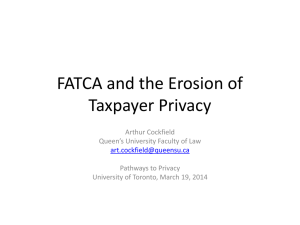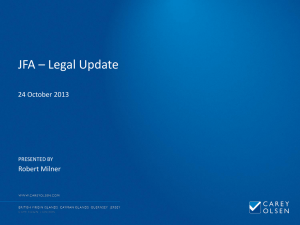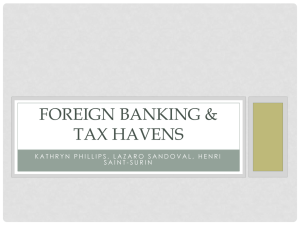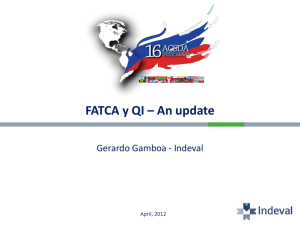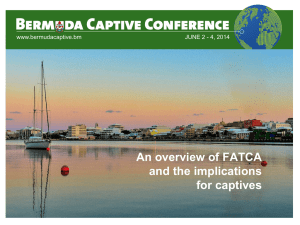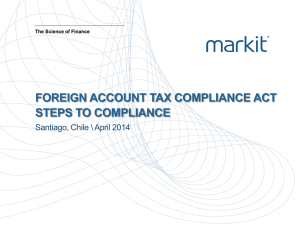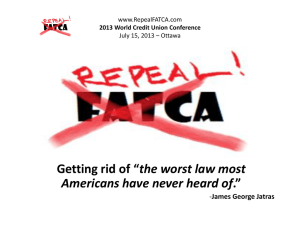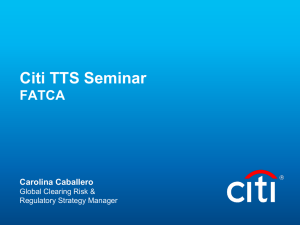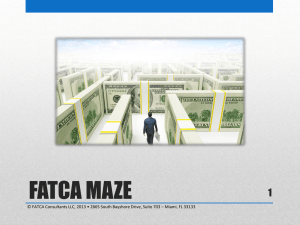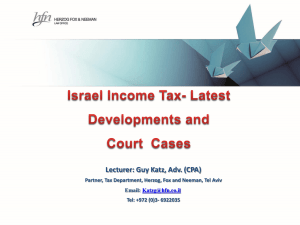FATCA Update STEP 13 02 14 public
advertisement
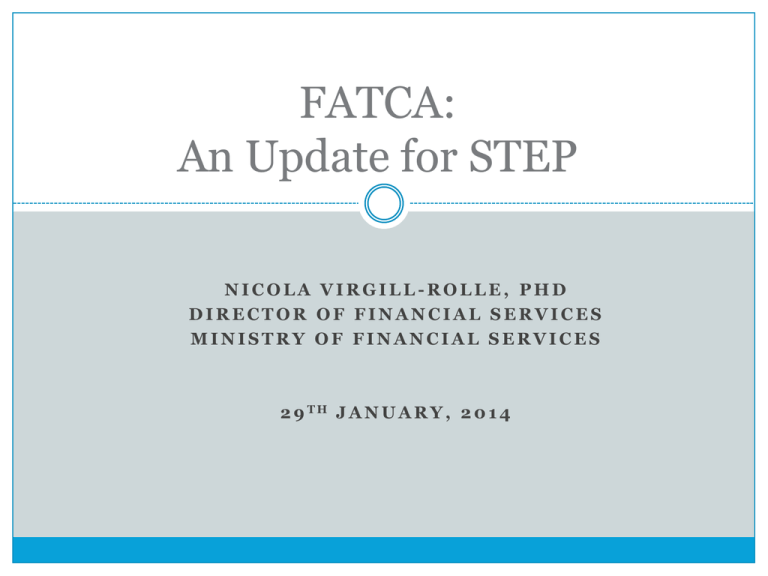
FATCA: An Update for STEP NICOLA VIRGILL-ROLLE, PHD DIRECTOR OF FINANCIAL SERVICES MINISTRY OF FINANCIAL SERVICES 2 9 TH J A N U A R Y , 2 0 1 4 Today’s Discussion 2 FATCA: Compliance Approaches The Bahamas FATCA Agreement and Legislation RFP Timeframes Examining the broader automatic information exchange environment FATCA: Approaches to FATCA: 3 Direct FFI agreement Receive GIIN and on FFI list if registered by 25 April, 2014 Intergovernmental Agreement Model 1: Government to Government Information Flows Reciprocal or non-reciprocal Model 2: Government directs FFIs to enter into a FFI agreement Do nothing: Face 30% withholding on US reportable payments to your institutions Choice of Model: Model 1 4 Based on the our experience, views of the Advisory Group, interactions with Industry: Model 1 was strongly preferred Cayman, BVI, UK (majority of countries so far) Best treatment for key Bahamian products: Trusts and funds Lower costs and reporting burdens for Bahamian financial institutions Report to Government of The Bahamas Higher infrastructure costs as systems within MoF need to be developed Costs depends on long term considerations Both agreements involve facilitating tax reporting on an annual and automatic basis versus information on request. Review of the Model 1 IGA 5 Preamble: Sets out the legal basis for the exchange of information. Sets out basic common goals and principles that underlie the IGA. TIEA with automatic exchange of information i.e. international tax compliance Sets out the confidentiality principle Characterizing the need for an IGA to address “domestic legal impediments” Review of Model 1 IGA, cont’d 6 Article 1: Definitions Financial Institution: 1. 2. 3. 4. Financial Account Custodial Institution (holding financial assets for the account of others as a business, substantial = over 20% of gross income over a 3 year period) Depository Institution (banking or similar business) Investment Entity (trading in money market instruments, FX, derivatives, securities, portfolio management, administering, managing funds on behalf of others) Conducts investments as a business or is managed by an entity that conducts investments as a business. Specified Insurance Company (insurance company or its holding company that makes payment with respect to Cash Value contract or an Annuity Contract). Account at all of the above; Debt or equity interest in a FI “established with a purpose of avoiding reporting in accordance with this Agreement” Account Holder Control of the account Review of Model 1 IGA, cont’d 7 Article 1, cont’d US Person Citizen or resident Corporate or partnership organized in the US or under the laws of the US A Trust, if a Court within the US would have authority to issue judgments etc, regarding its administration. where one or more US persons control substantial decisions of the trust, or an estate of a decedent that is a citizen or resident of the US (based on US IRS Code) Specified US Person Exceptions to “US persons” (i.e. US persons already falling within the regulation of the IRS or those explicitly exempt from the IRS under US tax law. Definition used to determine “US Reportable Accounts”. Review of Model 1 IGA, cont’d 8 Article 1, cont’d Related Entity (controls the other entity or the two entities are under common control, including direct and indirect ownership of more than 50%. Controlling Person: natural persons who control. In the case of the trust: settlor, trustees, protector, the beneficiaries or class of beneficiaries or other natural persons exercising “ultimate effective control” over the trust or other similar legal arrangements. Consistent with the FATF Recommendations. Terms not defined: Meaning must be mutually agreed or takes the meaning of the country which has the term. (or use definitions in the Regulations see Art 4). Review of Model 1 IGA, cont’d 9 Article 2: Obligations to obtain and exchange Information which must be obtained with respect to US Reportable Accounts (re: controlled by US Specified Persons) on an annual basis Name, address and TIN of US Specified Persons that is an account holder and is identified as having one or more controlling persons that our Specified US persons Account number Name and GIIN of FI Account balance or value, gross interest [Taxable] value associated with a custodial account Review of Model 1 IGA, cont’d 10 Article 3: Time and Manner of Exchange of Information By Sept 2015 with respect to 2014 accounts: core ID and balance/ value information. Existing accounts as at 30 June, 2014 – if TIN not in your records, use the date of birth if you have it. By September 2016, with respect to 2015 accounts: more detailed information with respect to interest payments, etc By September 2017 and onwards, with respect to 2016 accounts: ALL information in the FATCA IGA. Review of Model 1 IGA, cont’d 11 Article 4: FI FATCA Requirements for Compliance You will be a “Reporting FI” under a Model 1 if: Identify and report to The Bahamas Government in accordance with the IGA and applicable Bahamas legislation and guidelines For 2015 and 2016 report to The Bahamas Government the name of NonParticipating FIs to which you have made payments and the value of those payments Comply with IRS Registration requirements Fulfill any QI withholding responsibilities for Non-Participating FIs, if applicable If not a QI, the FI reports to the payor the information required to make a withholding in the case of a witholdable payment to a NPFI Review of Model 1 IGA, cont’d 12 Article 4, cont’d No requirement to close or withhold from a recalcitrant account, so long as US receives the information ultimately. Retirement plans are deemed compliant so long as they are regulated or subject to predetermined contractual or legal arrangements. But accountable to Bahamas Government, must comply condition. Potential legislative action needed on pensions funds. Clearly sets out that if a FI has a Related FI that cannot comply with FATCA because of legal impediments, that FI is still compliant, so long as they report any payments made to the non-Compliance Related FI and any US accounts (as permitted by law) and the Related FI doesn't solicit US accounts that are held by persons not resident in the jurisdiction and not used by the PFI to circumvent FATCA. Review of Model 1 IGA, cont’d 13 Article 5: Collaboration on Compliance and Enforcement Minor and Administrative Errors: updated IGA has US notifying Bahamas Government and Bahamas obtaining the corrected information from FI. Significant Non-Compliance: US notifies Bahamas; domestic FATCA law applied; 18 months to resolve, otherwise FI no longer a PFI and withholding occurs. Explicitly states that Third Party Service Providers may be used to comply with FATCA, but the responsibility remains with the FI. The Bahamas must prevent practices intended to circumvent FATCA Review of Model 1 IGA, cont’d 14 Article 6: Mutual Commitment to Enhance EOI Commitment to work on further approaches to deal with foreign passthru payments and gross proceeds. Commitment to develop a common reporting and exchange model with OECD, EU, etc Commitment to obtain US TINs by 1st January 2017. Article 7: Most Favoured Nation Clause Article 8: Consultations and Amendments Article 9: Annexes Article 10: Terms of Agreement: enter into force dates – when all internal procedures have been completed; 12 months notice to terminate; future consultation on further cooperation by December 2016 Review of the Annexes 15 Review of Annex II under Models 1 and 2 Trustee documented trust Deemed compliant under Model 1 (no registration, report through trustee, if necessary) Certified deemed compliant under Model 2 (report through trustee, if necessary) Sponsored investment entity (PTCs, Master Feeder Fund Structures) Model 1 - “If the sponsoring entity identifies any U.S. Reportable Accounts with respect to the Financial Institution, the sponsoring entity registers the Financial Institution pursuant to applicable registration requirements on or before the later of December 31, 2015 and the date that is 90 days after such a U.S. Reportable Account is first identified;” Model 2 – “Prior to December 31, 2015, the sponsoring entity has registered the Financial Institution with the IRS pursuant to the registration requirements set forth in paragraph C of section VI of this Annex II;” FATCA and Trusts 16 Trusts with a trustee who is a 'reporting financial institution', typically a corporate entity. In these circumstances the trust is a 'trustee documented trust' and does not need to register for FATCA reporting. But the trustee does need to register, and will have to report on the trusts for which it acts as trustee. If the trust is not a trustee documented trust, the next test examines if the trust has an 'investment entity' responsible for managing the trust or its assets – for example because the trust has engaged a fund manager on a discretionary basis. If it does, the trust is also deemed to be an investment entity and does need to register and report. It is possible that trusts in this position can acquire the status of ‘sponsored investment entities’ if they can arrange for another financial institution to report for them. Trusts that do not fall into either of the above groups are generally NFFEs and need not register or make FATCA reports. Instead they will be reported on by the financial institutions they interact with. – Source: STEP “UK trustees cannot afford to ignore US FATCA law” http://www.step.org/uk-trustees-cannot-afford-ignore-us-fatca-law#sthash.szxUIERs.dpuf Annex 1 Review: Due Diligence Requirements 17 Pre-existing Accounts (as at 30 June 2014) Under $50,000 no need to review, identify or report Over $50K, but under $1m Over $1m, then High Value Accounts Electronic record search to determine US indicia If US indicia found, but claims Not a US Account, then steps must be taken to prove this (see various US forms) Electronic Record Search Paper Record Search (except when a full database exists) Relationship Management Inquiry for Actual Knowledge Due diligence is a one time review Must monitor account balance classification changes Exceptions for due diligence already done for QI status Annex 1: Review 18 New Individual Accounts: Exempted – Under $50K, cash value insurance contract under $50K. Self certification to determine US status (new KYC) If US, must get Tax Identification Number (TIN) Must be built into AML/KYC standards If there is doubt about the original self certification, it must be done again Annex 1: Review 19 Entity Accounts Pre-existing - Under $250,000 no review, reporting. Reporting required for: Over $250,000 at 30 June, 2014; or an account which was low value, but goes to over $1m on the last day of 2015. Determine whether the account is held by US persons, by passive Non Financial Foreign Entities (NFFE) controlled by US persons or by Non-participating Financial Institutions. New accounts: Under $50K not required to be reviewed, reported The Bahamas Agreement: Status Update 20 Where are we now? Identified key clauses in Model IGA for negotiation Reviewed Swiss/ Cayman/ UK Reviewing whether Amendments necessary for TIEA to enable AEOI An agreement which implements FATCA. Legislation, Competent Authority Agreement and Industry Guidelines 21 Legislation will outline: What information is to be kept Compel the FI to undertake due diligence procedures Compel the FI to send the information to the Competent Authority Allow the Competent Authority to send the information to the IRS Define Penalties for Non Compliance. Competent Authority Agreement will define how the IRS interacts with Bahamian FFIs and the competent authority; Industry specific guidelines are needed to answer FAQs (no comfort rulings). Regulator assistance will be needed. Request For Proposals 22 RFP for the development and implementation of the FATCA reporting system The FATCA system development process: Bids have been received and opened Reviewing the bids with set criteria Short list to be developed Vendor demonstrations Choice of Vendor Product and Process Development Extensive testing and training Roll out of the new product and guidelines Goals of the FATCA Electronic Reporting System Project 23 General To enable The Bahamas to meet its data collection and reporting obligations under a Model I FATCA agreement; Specific To advise on the best approach to ensure that an electronic reporting system is developed which comprehensively captures all of the relevant information from the relevant financial institutions for the purpose of FATCA reporting under a Model I agreement. To advise on the best approach to ensure that all of the relevant entities report to the Competent Authority in the most secure manner for the purpose of FATCA reporting under a Model I agreement. To advise on the best approach to ensure that the Competent Authority can securely transmit the information from the reporting financial institutions for the purposes of FATCA to the United States Internal Revenue Service. To advise on the best approach to appropriately and adequately staff the department within the Competent Authority that will be responsible for the implementation of FATCA and the ongoing compliance of The Bahamas with respect to FATCA. To build and deploy, within the agreed upon timeframe and the agreed upon specifications, a FATCA reporting system. To train the relevant stakeholders in the use of the FATCA reporting system. To participate in roll-out activities associated with the launch of the system. Timeframes April, 2014 Vendor Chosen September 2013 - RFP Released Today … February 2014 Draft Legislation Released for Industry Consultation June 2014 – Guidelines Released to Industry July 2014 to February 2015– FATCA System to be built FATCA Reporting 2015 And the Future Holds? 25 Bahamas ahead of the curve with is financial services model Movement towards added value services, structuring Small skills gap in limited areas in the immediate short term, but MoFS programmes will ensure that the gap is identified and filled. Tax compliant structures are key New world of tax transparency (From Europe to Latin America) Sovereignty has made The Bahamas more attractive. Rebranding of Bahamas in terms of what it actually offers already Full Business Centre Trusts, banks, funds, insurance, services for the wealthy, second homes, yacht services, aircraft services, arbitration. Supported by professionals with experience. Strong compliance environment. The future is bright – and these are not just words. Questions? 26 Thank You!
